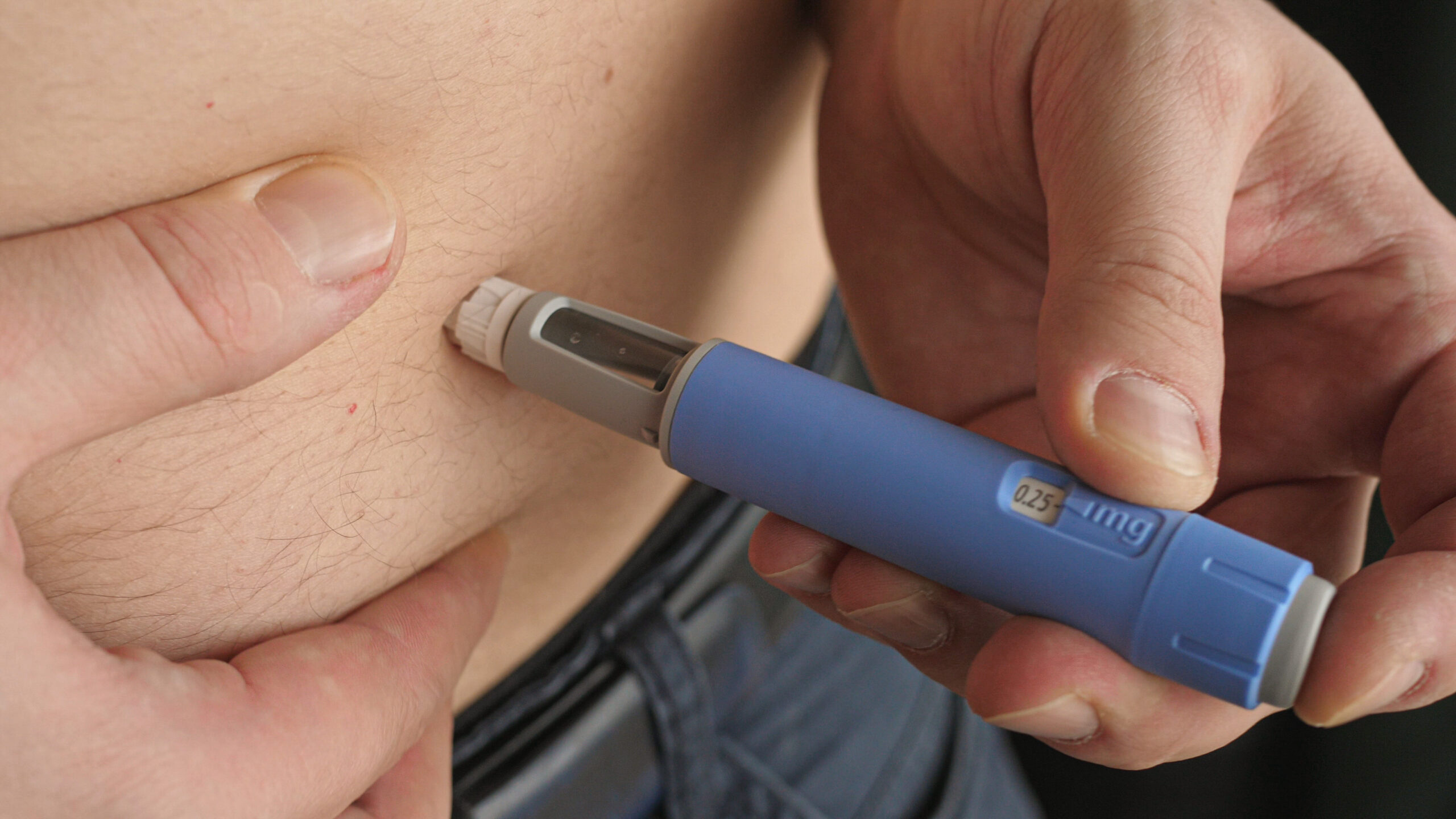If you are considering asking your medical team about starting Ozempic, then it’s important to know the ins and outs of the drug, including how it’s used, the dosage, and any potential side effects.
In this article we’ve broken down the Ozempic basics into a few simple topics, such as:
- What exactly Ozempic is
- What Ozempic injections are plus how they work
- How Ozempic pen injectors are used
- The potential side effects of Ozempic
- Precautions an Ozempic user should take
- What interactions Ozempic has
- How to deal with an Ozempic overdose or missed dose
- Frequency of use
- Storing Ozempic
- Frequently asked questions.
Ready to learn more? Read on!
What Is Ozempic?
Ozempic is a semaglutide formulation owned and distributed by Novo Nordisk for the treatment of type 2 diabetes in adults (note that it is not approved for use in children). It can also reduce the risk of major cardiovascular events, including stroke, heart attack, and death.
Semaglutide is a glucagon-like peptide-1 (GLP-1) agonist, intended to lower blood sugar and improve glycemic control in patients. You may see semaglutide marketed under different names, including Wegovy and Rybelsus. Victoza is another GLP-1, though it contains liraglutide, not semaglutide.
Ozempic, when supplemented with diet and exercise, is also frequently prescribed to support weight-management amongst diabetic patients or those with a BMI over 27.
What Are Ozempic Injections?
Ozempic injections refer to how the drug is administered.
Unlike some other medicines, Ozempic is self administered by patients via subcutaneous injection once weekly. This injection is performed with an Ozempic pen injectors, a consumer-friendly hypodermic needle, similar to an EpiPen.
Patients are encouraged to rotate injection sites, and to avoid injecting into veins or muscle tissue.
How Do Ozempic Injections Work?
Ozempic’s active ingredient is semaglutide. Semaglutide helps to regulate blood sugars in the body by increasing insulin secretion from the pancreas when your blood sugar levels are high.
It also has a side effect of suppressing appetite in some patients, which can help with weight management, especially when paired with a healthy diet and exercise.
Here’s the full breakdown you need to know for what exactly happens in your body when you take Ozempic.
Increasing Release of Insulin on Blood Sugar Elevation
Semaglutide produces some of the same effects as the human incretin glucagon-like peptide-1 (GLP-1), promoting insulin secretion and blood sugar disposal.
Insulin inhibits blood sugar spikes — meaning that if you have type 2 diabetes, you’re less likely to suffer from hyperglycemia when on semaglutide, and have better glycemic control overall.
Production of Less Glucose from Liver Stores
Glucose is synthesized and released as carbohydrates by the liver, which raises your blood sugar levels. This happens when your liver is stimulated by the production of glucagon.
Semaglutide helps to suppress the production of glucagon, which therefore means that your liver will not produce glucose, preventing associated blood sugar spikes.
Reduction in Appetite
GLP-1 is naturally released after eating, stimulating the production of insulin and inhibiting that of glucagon.
One of the common side effects of increased insulin production and glucagon suppression is a loss of appetite, or suppression of hunger. Semaglutide mimics GLP-1, and produces similar effects.
When combined with healthy diet and exercise, or other lifestyle changes, semaglutide can be an extremely effective medication to assist with weight management.
How to Use an Ozempic Pen Injector
Novo Nordisk supplies a comprehensive guide to the use of their Ozempic pens, including this handy video. If you’re unsure about these instructions, consult your medical team for assistance.
Generally:
- Your Ozempic pen should be clearly labelled and contain clear, colorless fluid
- Use a fresh needle every time, and be sure you safely dispose of it afterwards
- Check and adjust the dose and flow of your pen before using
- Inject Ozempic subcutaneously (ie, into the fatty tissue, just beneath the skin), avoiding any muscle or veins.
Prior to its initial use, an Ozempic pen should be refrigerated at a temperature between 36–46ºF. After first use, you can return your pen to the refrigerator or keep it at a room temperature between 59–86ºF.
You must dispose of your pen in a sharps safe disposal container, no later than 56 days after first use.
Never share your Ozempic pen with anyone else, even if you’ve changed the needle, as this can lead to serious infection.
Are There Side Effects of Using Ozempic Injections?
There are a number of very serious possible side effects you could experience as a result of Ozempic injections.
In clinical studies of Ozempic, the most commonly reported side effects were:
- Gastrointestinal upset (upset stomach), including nausea, constipation, diarrhea, vomiting, gas, and burping
- Fatigue
- Dizziness
- Headache
- Shortness of breath
- Changes in sense of taste.
In addition to the more common side effects, Ozempic use can also lead to:
- Hypoglycemia (dangerously low blood sugar)
Symptoms include: irritable mood, confusion, sleepiness, weakness, headache, seizures, erratic heartbeat, unconsciousness, coma, or death
- Pancreatitis (inflamed pancreas)
Symptoms include pain and/or swelling in the abdomen, fever, back pain, and gastrointestinal upset
- Kidney injury or failure
Symptoms of kidney problems include confusion, fatigue, nausea, irregular or increased urination, swelling of the joints, and (without medical intervention) death
- Gallbladder issues
Symptoms include rapid weight loss, pain, sweating, loss of appetite, and nausea
- Impaired vision (diabetic retinopathy)
Symptoms include blurred sight, poor night vision, loss of vision, and dark spots in your eyes
- Severe allergic reactions
Signs you’re having an allergic reaction include itching, redness, a rash or hives around the injection site, swelling of the face, lips, tongue, or throat, difficulty breathing after taking semaglutide
- Medullary thyroid carcinoma (thyroid cancer)
Symptoms of thyroid tumors include a lump in the throat, hoarseness, neck pain, coughing, trouble breathing and swallowing, and (if left untreated) death.
If you have any of the above more serious side effects, stop your use of Ozempic immediately and contact your medical team, or go directly to the ER at your local hospital.
What Precautions to Take with Ozempic Injections
The most important precaution to take with Ozempic injections is making sure you consult with your medical team first. In Canada, Ozempic is only available by prescription.
Semaglutide can have contraindications with other medications, so be sure to tell your medical team about any other prescription drugs you’re currently taking, including vitamins.
Additionally, if you’re pregnant or trying for a baby, be sure to discuss the risks of starting Ozempic with your medical team.
Understanding Ozempic Injection Interactions
There are 247 known drug interactions with Ozempic. It’s extremely important that your medical team has all the information regarding your prescription, over the counter, and illicit drug use.
Do not use any drugs in conjunction with Ozempic without proper medical supervision and advice.
What to Do in Case of an Overdose
An Ozempic overdose will lead to hypoglycemia. Critically low blood sugar can be fatal and is characterised by:
- Shaking, dizziness, and weakness
- Headache, nausea, and vomiting
- Mood changes
- Seizure or fitting
- Unconsciousness and eventual coma.
In the advent of an Ozempic overdose, it is critical to call the patient’s medical team immediately. If that medical team is unavailable, or symptoms worsen, do not hesitate to dial 911 for emergency help.
What to Do in Case of a Missed Dose
Ozempic is taken weekly. If you are still within five days of the missed dose, it’s not too late to take it.
If you have passed five days, skip the dose and inform your medical team.
Never double your dose — this can lead to a rapid and dangerous drop in blood sugar.
Tips for Storing Ozempic Injections
An unused Ozempic pen should be refrigerated at a temperature between 36–46ºF.
In between uses, an Ozempic pen should be stored in a refrigerator, or kept at a room temperature of 59–86ºF.
Dispose of your Ozempic pen no later than 56 days after its first use.
How Often to Have Ozempic Injections?
Ozempic is designed to be administered once a week, every week.
As always, follow your medical team’s advice, as this may differ per person.
Key Takeaways
Ozempic is a prescription medicine, used in the treatment of type 2 diabetes, or to assist with weight management in those with a BMI of over 27. It should not be used in any context other than a medically-approved treatment plan.
Always consult your medical team in regards to dosage, regime, and possible interactions with other drugs or illnesses.
If you are experiencing adverse symptoms of Ozempic, contact your medical team or emergency services immediately.
Ozempic Injection FAQs
What is Ozempic used for?
It is used for the treatment of type 2 diabetes in adults (note that it is not approved for use in children). It can also reduce the risk of major cardiovascular events, including stroke, heart attack, and death. It is intended to lower blood sugar and improve glycemic control in patients. Ozempic, when supplemented with diet and exercise, is also frequently prescribed to support weight-management amongst diabetic patients or those with a BMI over 27.
Semaglutide helps to regulate blood sugars in the body by increasing insulin secretion from the pancreas when your blood sugar levels are high.
It also has a side effect of suppressing appetite in some patients, which can help with weight management, especially when paired with a healthy diet and exercise.
Who should not take Ozempic injections?
Ozempic is not intended for certain people, including:
- Those with type 1 diabetes
- Those with a personal or family history of thyroid cancer
- People with allergies to semaglutide, or other ingredients in Ozempic.
If you experience an allergic reaction, contact your medical team immediately.
If you’re pregnant or trying for a baby, you should consult your medical team before starting Ozempic.
Should I avoid certain foods while taking Ozempic injections?
You shouldn’t need to avoid specific foods while taking Ozempic, unless you are experiencing nausea or stomach upset. In that case, avoid overly sweet or greasy meals.
There are no foods that are known to have specific negative interactions with Ozempic. However, diabetes patients are frequently at an elevated risk of heart disease or heart attack. For this reason, eating foods that support stable blood sugar levels and a healthy heart are encouraged.
How does Ozempic work?
Insulin inhibits blood sugar spikes — meaning that if you have type 2 diabetes, you’re less likely to suffer from hyperglycemia when on semaglutide, and have better glycemic control overall.
Glucose is synthesized and released as carbohydrates by the liver, which raises your blood sugar levels. This happens when your liver is stimulated by the production of glucagon.
Semaglutide helps to suppress the production of glucagon, which therefore means that your liver will not produce glucose, preventing associated blood sugar spikes.
Does Ozempic Increase Insulin Production?
One of the common side effects of increased insulin production and glucagon suppression is a loss of appetite, or suppression of hunger. Semaglutide mimics GLP-1, and produces similar effects.
When combined with healthy diet and exercise, or other lifestyle changes, semaglutide can be an extremely effective medication to assist with weight management.
Sources
- https://www.novonordisk.com
- https://medlineplus.gov/
- https://www.novonordisk.com.au/
- https://www.ozempic.com/
- https://www.bmj.com/
- https://www.nejm.org/
- https://my.clevelandclinic.org/
- https://eprints.qut.edu.au/
- https://www.houstonchronicle.com/
- https://www.novo-pi.com/
- https://www.medicalnewstoday.com/
- https://www.drugs.com/
- https://www.healthline.com/health/drugs/ozempic-dosage
- https://www.ozempic.com/faqs.html
- https://diabetesstrong.com/foods-to-avoid-ozempic






